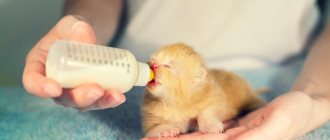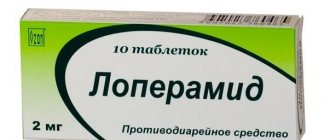Many cat owners use sodium sulfacyl for cats without even realizing that they can cause irreparable harm to their pet. Human eye drops "Albucid" provoke a severe burning sensation on the mucous membrane of the animal's visual organ. This can cause burns to the cornea and even loss of vision, especially in kittens. Therefore, in case of inflammatory processes in a cat, it is contraindicated to drip sulfacyl; you should urgently contact a veterinary clinic. And only after a complete examination and diagnosis should you begin treating your cat’s eyes with recommended medications.
How to give Sulfacyl to a cat?
Sulfacyl Sodium drops are a product produced for the prevention of eye diseases.
If your cat shows signs of conjunctivitis, redness of the eyelids or pus, medical intervention is essential. A veterinarian will tell you whether cats can take Sulfacyl Sodium. Drugs are selected according to the condition of the animal’s body. The principle of action of the substance Sulfacyl is based on imitation of para-aminobenzoic acid. This is a component required for the life of microbes. Sulfacyl imitates the properties of the ingredient and initiates a chemical reaction. This makes critical changes to the structure of the bacteria, which helps eliminate the infection.
Instructions for use
Using this product for cats requires extreme care. First, Albucid is applied to a cotton swab, with the help of which purulent formation is removed from the eyes. Next, using a cotton swab, the medicine is applied to the corners of the eyes, to places where inflammation and redness are observed.
Treatment is carried out about 3 times a day, but only if increased suppuration and damage to the eye area is recorded. Otherwise, your cat should be given Sulfacyl only on the first day.
The problem is that pets, like a small child, do not like this “operation”. The animal is disgusted by the smell, so the owner will have to be patient to carefully apply the drug and not injure the cat. Recovery time varies from 2 to 5 days depending on the level of eye damage.
Particular care is taken when a dog or cat’s eye does not open due to suppuration. Do not try to open your eyelids. This can lead to damage and injury to the affected areas and disturbances in the structure of the mucosa.
Veterinarians recommend moistening a cotton swab in warm water and gently treating the “crusts” of the cat’s eyes. The eyelids open randomly when the dried crust is partially dissolved. Next, Sulfacyl is instilled.
How to administer drops correctly?
- The patient should be placed on a pillow. Healthy care is below.
- Retract the auricle and inject the required amount of the drug.
- The dosage is determined by the attending physician, who is based on the intensity of the inflammatory process.
- Adults are usually given 2-3 drops at a time
- Infants are prescribed 1 drop at a time.
As soon as you finish administering the drug, experts advise massaging your ear for 10-15 minutes. This is done for better absorption of the medicine. To avoid complications and keep warm, the ear opening should be closed with a cotton swab or a small cotton ball.
The course of treatment is determined by the attending physician. As a rule, with otitis, it is 7-10 days. If your symptoms go away immediately after taking the drug, you do not need to stop treatment, as the pain will appear again if the inflammatory process is not treated.
If doctors diagnose purulent otitis, they prescribe 30 percent drops with turunda placed in the ears for 30-40 minutes. After removing the ear swabs, the ears should be rinsed with warm water and wiped dry.
Contraindications and side effects
Doctors' advice is to contact a veterinarian. The cat's body may have an individual intolerance to the components of the drug. Examinations are mandatory for pregnant cats, kittens and mature cats, whose bodies are usually sensitive to any synthetic products.
For a pet, using medication is an unpleasant and often painful procedure. After instillation, redness of the eyes and itching are observed, which is why the cat may try to scratch itself. Therefore, it is better to hold your pet in your arms for the first minutes after receiving it, even against its will.
If the capsule liquid gets into your fur or leaks out of your eye, there is no need to worry. Sulfacyl is not a toxic product and does not leave any effects on the skin.
Instilling Sulfacyl Sodium into a cat's eyes for a long period is not recommended. On average, the liquid is instilled for 2-3 days, after which the components begin to fight the infection. If you use the drug for more than a month, you can destroy the cat’s immunity, and this already threatens the appearance of other diseases.
ALBUCID (Sodium Sulfacyl) /
- Medicines Obstetrics and gynecology
- Anesthetics
- Antibacterial, antimicrobial and anthelmintic drugs
- Hepatotropic agents
- Homeopathy
- Dermatology
- Immunotropic agents
- Treatment of the gastrointestinal tract
- Oncology
- Ophthalmology
- Rheumatology, neurology
- Respiratory and antihistamines (antiallergic)
- Cardiovascular and diuretic drugs
- Metabolism
- Urology and means of correcting sexual function in men
- Central nervous system and drugs used to treat smoking, alcoholism, drug addiction
- Endocrinology
- Antifungal
- Accessories for feeding
- Glucometers
- First aid kits
- Lubricants
- Cotton wool, cotton swabs
- Medical procedures
Useful materials:
- Cutaneous horn General description of the disease Cutaneous horn on the forehead or face (ICD 10 code - L57.0) -...
- Itching and odorless discharge Main causesBefore considering the factors that provoke the appearance of discharge that has a sour odor, it is necessary to immediately note...
- Discharge in women What kind of discharge between menstruation is considered normal? Female discharge normally consists of mucus from the cervical canal, dead...
What you need to know about eye diseases
Eye drops Sulfacyl Sodium for cats is an essential element of the first aid kit. If a kitten's eyes are not treated in childhood, the problem will return in adulthood and can lead to complete loss of vision.
The choice in favor of Sulfacyl is explained by a number of advantages:
- This is a relatively safe drug with virtually no side effects. The main condition is the pet’s strong immunity.
- The product is suitable for the treatment of kittens sensitive to any drug intervention. Sulfacyl will not have a negative effect on the body.
- The price category of the drug is optimal. You can purchase the composition at an affordable cost.
- For treatment you will need a minimum of capsules. One package will last for a long time. The medicine is designed for a long shelf life.
Timely treatment of the cat will provide good results. Sulfacyl acts immediately and localizes the source of inflammation, which prevents vision complications. For young cats, eye problems are natural, so experienced housewives try to constantly maintain a supply of Sulfacyl in the house.
Description of the drug
To treat an ophthalmological disease, the pet is prescribed eye drops. Sulfacyl - Sodium for cats is sometimes used in veterinary practice, but the dose of the drug is set depending on the condition of the animal and the severity of the disease.
Eye drops are produced in plastic bottles with a dispenser. Product volume is 5 and 10 ml.
1 ml of 20% solution contains 20 ml of the active substance Sulfacetamide. The drug is used to prevent the growth and reproduction of pathogenic microflora.
A post shared by ENT⚡️OTOLARYNGOLOGIST⚡️MOSCOW (@dr_ingri) on Feb 25, 2021 at 6:54am PST
The medication destroys the amino acids produced in the bacterial cell, causing the death of the pathogen. The effect of the drug is due to the activity of sulfacetamide, which is effective against a large number of microbes. Drops disrupt the formation of tetrahydrofolic acid, which is involved in the creation of purines and pyrimidines.
The drug has an effect on the following microorganisms:
- actinomycetes;
- E. coli;
- shigella;
- Vibrio cholerae;
- clostridia;
- corynebacteria.
The medication has a pronounced antibacterial effect, part of the drug enters the systemic bloodstream. The maximum amount of the drug in the cornea after instillation is 3 mg/ml. The drug remains in the tissues surrounding the eye for 4 hours. The absorption of the drug is enhanced if eye drops are applied to the damaged mucous membrane of the cornea.
Composition and properties
The pharmaceutical preparation "Albucid" contains an active ingredient and auxiliary components. The main substance of the drug is sulfacetamide. Its amount in the ophthalmic solution depends on the concentration of the medication. The ophthalmic emulsion also contains additional components such as:
- hydrochloric acid;
- sodium thiosulfate;
- distilled water.
The drug cures the disease caused by the activity of streptococcus.
- chlamydia;
- streptococcus;
- gonococcus;
- coli;
- staphylococcus
whether the medicine helped or did not help get rid of the disease, what complications and side effects were observed, perhaps not stated by the manufacturer in the annotation. Analogues of Sulfacyl sodium in the presence of existing structural analogues. Use for the treatment of conjunctivitis, blepharitis and neonatal blenorrhea in adults, children, as well as during pregnancy and lactation. Albucid composition.
Sodium sulfacyl (albucid) is an antibacterial agent for topical use in ophthalmology, a sulfonamide derivative. Has a wide spectrum of antimicrobial action. Has a bacteriostatic effect. The mechanism of action is associated with competitive antagonism with PABA and competitive inhibition of dihydropteroate synthetase, which leads to disruption of the synthesis of tetrahydrofolic acid, necessary for the synthesis of purines and pyrimidines.
Sulfacetamide (active ingredient Sulfacyl sodium) is active against gram-positive and gram-negative bacteria (including pathogenic cocci, Escherichia coli), Chlamydia spp., Actinomyces spp.
Compound
Sulfacetamide excipients.
Pharmacokinetics
When applied topically, it penetrates into the tissues and fluids of the eye. Absorbed into the systemic circulation through the inflamed conjunctiva.
Indications
- purulent corneal ulcers;
- conjunctivitis;
- blepharitis;
- gonorrheal eye diseases in newborns and adults;
- prevention of blenorrhea in newborns.
Release forms
Eye drops 20%.
There are no other dosage forms, be it ointment or nasal drops.
Instructions for use and method of use
Apply 2-3 drops into the lower conjunctival sac of each eye 5-6 times a day.
To prevent blenorrhea in newborns, 2 drops of the solution are instilled into the eyes immediately after birth and 2 drops after 2 hours.
Side effect
- itching;
- redness;
- swelling.
Contraindications
hypersensitivity to sulfacetamide and other sulfa drugs.
Use during pregnancy and breastfeeding
Systemic absorption of the drug when applied topically is minimal. The drug can be used during pregnancy and breastfeeding according to indications.
Use in children
The drug can be used in children according to indications from the moment of birth.
special instructions
Patients hypersensitive to furosemide, thiazide diuretics, sulfonylureas, or carbonic anhydrase inhibitors may be hypersensitive to sulfacetamide.
Drug interactions
When applied topically, sodium sulfacyl is incompatible with silver salts.
Analogs of the drug Sulfacyl sodium
Structural analogues of the active substance:
- Sulfacetamide;
- Sodium sulfacetamide;
- Sulfacyl sodium bufus;
- Sulfacyl sodium Vial;
- Sulfacyl sodium DIA;
- Sulfacyl sodium solution 20%;
- Sulfacyl sodium MEZ.
If there are no analogues of the drug for the active substance, you can follow the links below to the diseases for which the corresponding drug helps, and look at the available analogues for the therapeutic effect.{amp}gt;How to give Sulfacil to a cat?
Instructions for use of albucid
There is no clear opinion about the benefits and harms of Albucid drops. Many veterinarians prohibit dripping sodium Sulfacyl into a cat’s eyes, since Albucid causes irreparable harm to the pet.
Reasons why treatment with Albucid is contraindicated for a pet:
- The medication is used only in ophthalmic practice for the treatment of diseases in humans.
- There are many anatomical differences in the structure of the organ of vision in animals and humans.
- Special veterinary drugs are used to treat pets: Anandin, Tsiprovet. Treating a small kitten with Albucid drops can be fatal.
If you drop Sulfacyl - Sodium into a cat's eyes, the pet will develop unpleasant symptoms:
- corneal burn;
- burning sensation on the mucous membrane of the eye;
- loss of vision.
Is it possible to put drops in a cat’s eyes and why?
Veterinarians often recommend avoiding human medications for dogs, cats, and other animals. Drugs for humans are contraindicated for pets, which is based on many factors. Human medicines are developed for therapeutic processes in humans. The body of cats is seriously different both externally and internally. Animals have a different microflora, body structure, and everything functions differently. The cat's organ of vision has a third eyelid. It further helps protect the eyes. The mucous membrane of a cat has a pH level that is different from that of humans, so for animals it is recommended to use veterinary drugs that are more suitable for them. The use of Albucid on a kitten can be especially dangerous.
The human ophthalmic solution “Albucid” is extremely contraindicated for treating the eyes of cats because if it is instilled, a burning sensation occurs in the area of the organ. Due to the greater sensitivity of the cat's organs, this effect can cause complete loss of vision as a result of a burn to the kitten's cornea. Death cannot be ruled out after the use of human medications for animal therapy. Even a non-concentrated solution can provoke an overdose and lead to intoxication of the pet’s body, as well as deterioration or loss of vision.
Animal-safe analogues
Self-medication is not recommended, because if the cat’s eyes are infected with microorganisms that are not sensitive to the active substance, then the therapy will not give positive results and may complicate the condition, and pathogenic bacteria will aggravate the situation during this time.
For the treatment of conjunctivitis in cats, veterinarians recommend Tsiprovet. The drug will quickly eliminate inflammation and will not cause harm to the pet’s visual organs, unlike Albucid. The doctor may also suggest using drops based on ciprofloxacin for kittens. If a cat has an allergic reaction to the medication, the veterinarian will prescribe Desacid or Decta-2. And also for the treatment of the visual organs, “Cifran”, “Anandin” or “Ciprolon” can be prescribed. Medicines help to quickly eliminate discomfort, relieve inflammation and alleviate the condition of the visual organs.
Pet owners are interested in whether it is possible to drip Albucid into the eyes of cats if the pet is sneezing, coughing, or has swelling around the lower eyelid.
Indications and contraindications for prescribing albucid
It is not always necessary for a cat to drip Albucid; whether it is possible to treat kittens’ eyes with this drug, the doctor will tell the owner of a small pet after making a diagnosis.
The instructions for the drug indicate indications for its use:
- conjunctivitis;
- blepharitis;
- keratitis;
- corneal ulcer;
- gonorrheal inflammation.
The drug should not be used for the following conditions:
- individual intolerance to the medication;
- allergic reactions;
- combined use with medications containing silver;
- when using local anesthetics.
All indications and contraindications apply to adults and children. This remedy is contraindicated for animals.
To treat a pet, medications are used: Floxal, Oftalmoferon, Tsiprovet, Levomycetin, Anandin, Iris, Bars. Self-use of the drug Sulfacyl-Sodium causes complications in your pet:
- loss of vision;
- worsening of the underlying disease.
It is difficult to cure an eye infection with Albucid; you should not self-medicate.
Side effects
When instilling the drug Sulfacyl - Sodium into the eyes, the following side effects may occur:
- burning;
- lacrimation;
- pain in the eyes;
- itching;
- allergic reactions.
Some owners use the drug Sulfacyl-Sodium for inflammation of the mucous membrane of the cat's eye, however, when instilling Albucid in kittens once a day, they do not know how many drops are needed in one eye. They believe that the medication dries out the mucous membrane and stops lacrimation. Your pet may experience a sharp deterioration in vision after such treatment.
When using the medicine, you may encounter negative side effects such as blindness. Frequent use of the drug leads to an overdose, pain and severe burning are felt.
In this case, you need to consult a doctor, change the treatment regimen or discontinue the medication. Side effects are pronounced if the drug has expired and its physical properties have changed.
Frequent phenomena after instillation of the drug are considered to be:
- photosensitivity;
- fever;
- redness of the sclera;
- edema;
- allergic myocarditis.
Kittens have more sensitive eyes, and after using Albucid they often develop keratitis.
20% Albucid is diluted with boiled water in a ratio of 1:3, 1 part of the drug is taken into an eye dropper, and 1-2 drops are injected into the pet’s sore eye. During the procedure, the animal behaves aggressively, bites, and scratches.
The medicine is used if the cat needs urgent medical care and there are no other eye drops. For viral infections, complex treatment is carried out; Albucid drops can only worsen the situation.
Sulfacyl sodium in veterinary medicine
Compound
Pharmacokinetics
Indications
Release forms
Eye drops 20%.
Side effect
Contraindications
Use in children
special instructions
Not true
Zinc sulfate eye drops. Add aseptically to eye drops. The isotonic equivalent of sodium chloride shows. The eye drops are administered aseptically. 1. pilocarpine g x. 2. resorcinol. 3. boric acid. 4. sulfacyl sodium.
Rinse with tea or vet. Buy Bars drops at the pharmacy
True, not true. Who cares? You can’t drip it, you still need to check it. The cat won't go blind, but nothing good will happen to it!
I was dripping levomycin
Well, as for going blind after the first time, it’s unlikely, but you still shouldn’t bury them, because the use of albucid can lead to a burn of the retina, and in humans too...
Any self-medication will do more harm than good. Treat with whatever your veterinarian prescribed.
Sodium sulfacyl eye drops are a broad-spectrum antimicrobial drug with a bacteriostatic effect. Eye drops are available in the form of a 20% solution of 0.2 g of sulfacetamide or 30% of 0.3 g of sulfacetamide.
The truth is that if she has toxoplasmosis/chlamydia, etc., then albucid will not help, and you will all become infected.
Rinse with tea and apply eye ointment with an antibiotic, the pharmacy knows
I don't know, yes
The active ingredient is sodium sulfacetamide, sodium sulfacyl. On the way, I stopped at the pharmacy and bought Sulfacyl drops, applied them several times at work, then at home, and woke up in the morning with red eyes.
No no no! If you don't want to hurt the dog!
My personal opinion is that everything related to the eyes requires a mandatory examination by a veterinarian. Albucid will not harm the dog. But it does not cure, it is only prevention. If an infection has already settled there, then you will not be able to help. And if it’s also viral and not bacterial, then in a couple of days everything will be very sad.
READ Nicknames for German Shepherds for boys and girls: 100 beautiful and popular names
Sulfacyl sodium is an albucide, i.e. eye drops. It stings a little when applied. I don't think it can do any harm. but this is my personal opinion.
Nnnnnnnnnnnnnnnnnnnnnnnnnnnnnnnnnnnnnnnnnnnnnnnnnnnnnnnnnnnnnnnnnnnnnnnnnnnnnnnnnnnnnnnnnnnnnnnnnnnnnnnnnnnnnnnnnnnnnnnnnnnnnnnnnnnnnnnnnnnnnnnnnnnnnnnnnnnnnnnnnnnnnnnnnnnnnnnnnnnnnnereeeeeeeeeeettttttttttttttttttttttttttttttt
Albucid is not used in veterinary medicine; this drug has a bad effect on the cornea of the eye and increases intraocular pressure. A good veterinarian knows this
The medicine Sulfacyl sodium eye drops belongs to the category of antimicrobial, antiseptic drugs. Pharmacological properties. The medication has a bacteriostatic effect, preventing the proliferation and development of microbes...
Black tea helps
To understand what the drug is, you need to comprehensively study its principles of action, its characteristic properties, methods of use, as well as dosage and contraindications.
In principle, this should go away on its own, just don’t give him any more sweets, otherwise he’ll completely glue his flippers together
Rinse with: eye drops, chamomile infusion or fresh tea leaves and apply tetracycline eye ointment
Take it easy and brew the tea, not too strong. Rinse with this cooker three times a day! should help!
I don’t know anything better than tea, but albucid may sting the eyes.
I washed mine with albucit, only diluting it 1/4 with boiled water. It helped.
Composition and release form. Mechanism of action. Indications for use. Method of administration and dose. Contraindications. Side effects. Overdose. Interaction. Special instructions. Analogues of Sulfacyl sodium. Price in pharmacies. Patient reviews.
Tetracycline ointment is best. Helps a lot. But smear until complete recovery. She is antiseptic.
Strong brewed tea
Strong tea leaves. In general, kltq and cats have common medications, but as for the eyes, I don’t know
You can wash it with a weak solution of potassium permanganate or furocelin.
There are special eye drops for cats and dogs... albucid, it’s unpleasant and next time the cat won’t give in... it’s better to use strong tea leaves...
SULFACYL SODIUM BUFUS, drops. Indications. Purulent corneal ulcers, conjunctivitis, blepharitis, gonorrheal eye diseases in newborns and adults, prevention of blenorrhea in newborns.
Albucid is sodium sulfacyl 33%, really, so as not to fizz, you can look in pharmacies for a concentration of 20%, only it is no longer albucid and will still be called sodium sulfacyl, you can also use a weak solution of furatsilin.
Mine had this happen - after tests at the veterinary clinic it turned out to be staphylococcus! Think.
Stronger brew
Any drops for conjunctivitis - levomycytin, sulfacyl sodium... helps quickly
Strong tea helps very well, try the brew, good luck
Eye drops Sulfacyl sodium is an aqueous solution of sulfanilamide, which has antimicrobial bacteriostatic properties. That is, it stops the proliferation of bacteria, which helps the body cope with the infection faster.
Albucid is NOT allowed!!! !If you don’t go to the vet, then try light anti-inflammatory drops, for example, “Diamond Eyes”, “Iris”. Drop into clean eyes (wipe off all the pus). If it doesn't go away, see a doctor.
Cats should not be given albucid (the veterinarian told us so), go to a veterinary pharmacy where they have special drops for animals.
Better tea.
Sodium sulfacyl is not recommended at all for use in veterinary medicine. Dogs do not have ARVI (colds with a runny nose in the human sense); a runny nose is most often a symptom of infection.
In general, you should go to another veterinarian before it’s too late...
Not true
Veterinary drugs. Veterinary diseases. Animal diseases, rules for breeding and caring for them, symptoms of the most common diseases and measures to prevent them.
Sulfacylum-natrium. para-Aminoben-zolsulfacetamide - sodium sodium salt of sulfacil. Synonyms sulfacyl soluble, sulfacetamide-sodium, albucid-sodium, etc.
Is it possible to drip “Albucid” into the eyes of cats and what consequences might this cause?
If a person has a pet, then he undertakes to bear full responsibility for its health, including treatment. The sore spot for many furry animals, especially in adulthood, is the eyes. That is why many owners are tormented by the question of whether it is possible to drip Albucid into the eyes of cats. It's worth looking into this in more detail.
Brief description of the drug
The eye drops contain an active substance called sulfacetamide. This drug is mainly intended for people, including it can be used for small children from the first day of life. There are several indications for its use:
- purulent conjunctivitis;
- inflammatory reactions;
- entry of foreign bodies into the organs of vision;
- ulcerative lesion of the cornea of the eye.
In addition, this drug is also used to prevent infectious or bacterial diseases of the organs of vision. But it is not as safe as it seems; side effects such as excessive lacrimation, itching and burning sensations, the appearance of a rash or red spots on the skin around the eyes, or pain in the visual organs are possible. Therefore, you should be careful about its use and first study the question of whether Albucid can be dripped into a cat’s eyes.
Sulfacyl sodium for cats for eye diseases
Cats' eyes are subject to inflammatory and infectious diseases from time to time. This is especially true for animals that often have the opportunity to walk outside. Such pathologies in certain cases can be treated with drugs that are intended for the treatment of diseases in humans. Sulfacyl sodium or Albucid is one of these drugs. Is it possible to drip sodium sulfacyl to cats? Both veterinarians and cat owners give conflicting answers to this question. It all depends on the severity of the disease and the individual characteristics of the animal.
- Indications for use Use of Albucid for cats
Indications for use
Sodium sulfacyl for cats is an antimicrobial drug that easily penetrates into the deep structures of the eye. The second name of the drug is more common - Albucid.
It is usually prescribed to people who are faced with the following diseases:
- purulent conjunctivitis; bacterial infections; ulcerative lesions of the cornea and other eye pathologies.
Most experts do not recommend dripping sodium sulfacyl into a cat's eyes. After all, the nature of eye pathologies in humans and cats will always be different, and accordingly, treatment must be adequate and suitable for the animal.
Use of Albucid for cats
Qualified veterinarians are categorical in their verdict: Albucid is strictly contraindicated for the treatment of cat eyes. This is justified by a number of reasons:
- The purpose of the medicine is the treatment of human diseases. Cats and people have completely different physiological characteristics and structural features of the visual organ. For example, cats have a third eyelid that provides additional protection to the eyeball. The person does not have this. Due to the large differences in the anatomical features and biological characteristics of humans and animals, it is impossible to use the same medications to treat two different organisms. To combat eye diseases in cats, experts have developed veterinary drugs that are no less effective than human drugs. It is prohibited to use sodium sulfacyl for cats when veterinary pharmacies offer drugs such as Anandin, Tsiprovet. These medications quickly stop the inflammatory process in the cat and cause him harm. It must be remembered that medications used by humans can cause the death of a pet. Sulfacyl sodium drops cause a strong burning sensation in the cat's eyes. Animal visual organs are more sensitive than human ones. Albucid can cause a burn to the eye cornea and aggravate the pet's condition. The use of even a low-percentage drug leads to an overdose of the active component and severe side effects. In some cases, the cat may even lose sight. Some breeders prefer to give cats Sulfacyl sodium eye drops because this drug is inexpensive and is sold in every pharmacy. However, it is worth remembering that the desire to save money and cure a cat without consulting a veterinarian can result in severe damage to the health of your beloved cat. Doctors' call not to self-medicate applies not only to people, but also to pets. On the Internet you can find a lot of reviews from cat owners who say that sodium sulfacyl does not harm cat's eyes. In particular, this applies to children's Albucid, which contains a small amount of active substance. The composition of children's drops includes 10% of the active ingredient. That is why some cat owners quite often treat kittens and adult cats with this drug and do not see anything as a warning in it.
Responsibility for treating your own cat rests with the owner. He can choose medications at his own discretion, but must remember one nuance. The reaction of a cat’s body to a particular medication used by humans is absolutely unpredictable. It is safer for your cat to buy special medications from veterinary pharmacies and not experiment with his health.
Expert opinion
Any cat diseases, including eye problems, are dealt with by veterinarians. They strongly do not recommend dripping Albucid into a cat’s eyes for several reasons:
- This drug is intended only for humans, and the structure of their visual organs is noticeably different from the structure of the visual organs of cats. Therefore, absolutely any human medicine is contraindicated for them, even if it has the most gentle composition.
- Many cats cannot tolerate the component included in its composition. This means that it will not only not have a positive effect in treatment, but will also lead to unwanted side effects and negative consequences.
- A pet's eyes are much more sensitive than a person's. That is why they are protected by an additional eyelid. After instilling Albucid into a cat's eyes, you may notice that it is experiencing unbearable pain, and the burning sensation can be so strong that the pet will completely lose the ability to see.
Many owners of furry animals claim that they were completely able to cure their cat’s eyes with a similar drug intended for infants. But veterinarians say that this is impossible to do, if the eye drops helped, this was only an isolated case of all possible cases.
Why can't cats be given Albucid?
Any qualified veterinarian will give a definite answer: Albucid as a medicine is strictly contraindicated for cats! There are a number of objective reasons for this:
- The drug is intended for the treatment of human pathologies.
- A person and a cat have completely different physiological features of the structure of their visual organs. For example, cats have a third eyelid, which provides additional protection to the eye, which cannot be said about the human eye. Due to the huge difference in the biological and anatomical structures of humans and cats, it is completely unacceptable to use the same drugs to treat two organisms that are dissimilar in structure.
- For the treatment of pets, special drugs have been developed that are in no way inferior in effectiveness to those used in human treatment. It is strictly forbidden to drip Albucid into a cat’s eyes when you can use alternative products for cats and dogs, such as “Dekta-2”, “Anandin”, or “Tsiprovet”. These medications will quickly eliminate the inflammatory process in your pet and will not harm him. Don't forget that some medications used by people can lead to the death of a pet!
- The components of Albucid drops cause a painful burning sensation in the cat's eyes, since the eyes of the animal are more sensitive than those of humans. This medicine can easily burn your pet’s cornea and, thereby, aggravate the situation of the sick cat. The use of Albucid, even with a low content of the active component, can lead to an overdose and painful side effects, including loss of vision.
- Often, some owners drip Albucid into the cat's eyes due to the availability and low cost of the medicine. Indeed, the price range of “human” drugs, such as chloramphenicol, for example, is significantly lower than their “feline” counterparts. The desire to save money and lack of time to visit the veterinarian can lead to dire consequences for the health of your pet. All warnings about the dangers of self-medication apply not only to the person himself, but also to our smaller brothers!
- Some cat owners claim that the use of Albucid has no harmful effects on the cat's eyes, especially if you use children's Albucid with a gentle content of the active substance. Children's drops of this drug contain a ten percent concentration of the active ingredient, so other breeders do not see anything wrong with putting Albucid in a kitten's eyes.
How to treat your pet is up to you! However, do not forget about one very important nuance. It is impossible to accurately predict the reaction of a pet’s body to the use of products intended for human treatment. It is much safer to purchase special medications for animals in specialized veterinary pharmacies.
How to treat?
So, it became clear that to the question of whether Albucid can be dripped into the eyes of cats, there is only one clear answer - this should not be done under any circumstances, since the consequences can be the most unexpected. In this case, pet owners are faced with another question - how to treat the eyes in case of inflammation or illness. In the first stages, you can do this with the help of drunk tea, after moistening a cotton pad in it. But if the animal’s condition does not improve, then you should contact a veterinary clinic, where a specialist will select the most appropriate treatment.
What medications should a cat have at home: collecting a first aid kit
Even if your furry pet is completely healthy, you cannot do without a first aid kit. Just like for a small child, there should be a separate first aid kit for a cat: after all, many human medicines are dangerous or useless for them.
The lack of veterinary education or the skills to give injections and dressings is not a reason to neglect medications at all, because it is the owner who provides basic care for the pet.
Vaccination, deworming, flea protection
This trio is a mandatory procedure that allows you to maintain your cat’s health, even if the animal does not leave the apartment.
Place in your “first aid kit” the cat’s veterinary passport (vaccination certificate) and records of previous visits to the veterinary clinic (they help track the disease over time). Make sure that there is a remedy for worms in the house (it is given 10 days before vaccination, the rest of the time - once every 3-6 months).
Flea drops or tablets are most relevant in the warm season, but if you live on the 1st floor, or the cat is free-range, you can catch parasites in winter.
Care of fur and claws
Fluffy cats need a comb (a regular slicker brush or a newfangled Furminator), and hairless cats need a special shampoo (they need to be bathed periodically to maintain healthy skin).
If you do not regularly brush the undercoat, it is recommended to give cats malt paste for natural hair removal.
Many owners trim their pets' nails themselves (this painless procedure is needed about once every 2 weeks) to save their hands, furniture and nerves. I don’t cut hair, but I have a nail clipper in my medicine cabinet! It is especially important to monitor the claws of older Persians, Britons, and Scots - sometimes their horny sheath stops changing normally and the claw grows into the pad, causing terrible suffering.
Eye and ear care
An ordinary healthy cat does not require such care. But sphinxes, for example, regularly have their ears cleaned due to increased formation of wax - then they need a special lotion (Otoclin, etc.) to soften the discharge.
Again, it is only necessary to wipe the eyes of Persians or exotics, or sphinxes, who have excessive lacrimation.
But you should definitely keep the medicine in your first aid kit in case of eye injury or conjunctivitis. Another cat can inflict it with its claw, and sometimes a curious pet pricks itself on a dry blade of grass/twig. If the eye is watery or the cat squints, first aid is to use antibiotic drops. Popular inexpensive drops are Levomycetin, but you need to drip them very often, and they don’t always work. Well proven:
But cats should not drip Albucid (sodium sulfacyl)! Tetracycline ointment is also useful - it is applied if there is so much discharge that the eye is stuck together with pus, or you need to go away for a long time (12 hours of work, etc.) and there is simply no one to put drops into the cat’s eye.
In case of vomiting or diarrhea
Cats often vomit; this is a natural feature of predatory animals. Just a little bit - he vomited and ran on. However, even seemingly harmless vomiting of wool sausages or “cleansing” the stomach after eating indoor plants can provoke gastritis. After each episode of nausea, I give the cat 2 ml of Phosphalugel and see how things go.
In case of diarrhea, it is good to keep Enterosgel at home (sorbents in powder form - Smecta, Polysorb are no worse, but they are inconvenient to give to cats). If you are far from veterinary clinics, you can also buy an intestinal antiseptic - enterofuril. In the form of a liquid suspension for children (Ersefuril, Stop-diar).
In case of injury
In case of any damage to the skin, the owner’s task is to prevent the wound from being licked. With its tongue, the cat not only introduces infection, but also interferes with healing (by tearing off the top layer like sandpaper). Therefore, it is good to keep an appropriately sized Elizabethan collar at home.
For treating wounds: scissors (cut the hair), tweezers, gauze pads and bandages, antiseptic (chlorhexidine, hydrogen peroxide, furatsilin tablets).
Various tools
First of all, a regular thermometer. In any unclear situation, stick a thermometer up your butt! Often this helps to clarify the situation (understand why the cat is lethargic and does not eat, predict the time of birth of kittens, etc.). The normal temperature for a cat is 37.5-39 C.
You should also keep disposable syringes of different sizes in your first aid kit. For capricious individuals, a retainer bag and a tablet dispenser will be useful, and if your pet walks in the country in the summer, a special device for removing ixodid ticks.











